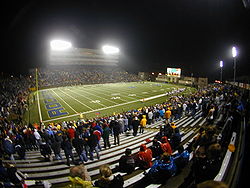Glass Bowl
 |
|
| Former names | University Stadium (1937–1945) |
|---|---|
| Location | 3044 N. Glass Bowl Dr. Toledo, Ohio 43606 |
| Coordinates | 41°39′25″N 83°36′49″W / 41.65694°N 83.61361°WCoordinates: 41°39′25″N 83°36′49″W / 41.65694°N 83.61361°W |
| Owner | University of Toledo |
| Operator | University of Toledo |
| Capacity | 8,000 (1937–1939) 11,500 (1940–1948) 12,800 (1949–1965) 15,900 (1966–1970) 18,210 (1971–1989) 26,248 (1990–present) |
| Record attendance | 36,852 (2001 vs Navy)[1] |
| Surface | Field Turf 2008 to present, replaced in 2016 AstroTurf 1975 to 2007 Grass 1937 to 1974 |
| Construction | |
| Broke ground | 1936 |
| Opened | September 27, 1937 |
| Renovated | 1990,2016 |
| Expanded | 1940, 1949, 1966, 1971, 1990 |
| Construction cost | $313,558 USD ($5.22 million in 2017 dollars[2]) $18 million (renovation) ($33 million in 2017 dollars[2]) |
| Architect | SSOE, Inc. (renovation) |
| Tenants | |
| Toledo Rockets (NCAA) (1937–present) Glass Bowl Game (NCAA) (1946–1949) Ohio Cannon (RFL) (1999) |
|
The Glass Bowl is a stadium in Toledo, Ohio. It is primarily used for American football, and is the home field of the University of Toledo Rockets. It is located on the school's Bancroft campus, just south of the banks of the Ottawa River. Known for its blend of old and new, it retains the traditional stonework around the field throughout all its expansions.
Originally known as University Stadium, it was built in 1936 at a cost of only $335,000 as a Works Progress Administration project. Originally the natural seating bowl held 8,000 in two sideline grandstands. There was a grass hill at the south end of the stadium, and at the open (north) end of the bowl were two stone towers (still standing), that served as makeshift housing for the football team in its early years. Following World War II, the stadium was renovated, with many glass elements. Because of this, and the city's concentration on the industry, the stadium was renamed the Glass Bowl in 1946. South end zone stands were added in 1966, and further expansion came following Toledo's 35-game win streak from 1969 to 1971, bringing capacity up to 18,500.
In 1990, the stadium had its largest expansion take place, adding a second level of seats to both sidelines. As part of the 1990 renovations, which cost $18 million, a three-story press box, which also includes 40 luxury suites, a 400-seat Stadium Club and sports information offices, and the Larimer Athletic Complex were built. The three-story press box, the second largest in the nation, was the greatest improvement in terms of upgrades, as the former press box was barely 30 feet long and only could hold approximately 50 people. Further improvements include a video scoreboard in the north end zone in 1999, and the upgrade to a Field Turf playing surface in 2008. In 2016 a 3.5 million dollar renovation took place, including replacement of the field turf, changes to the facade, updating concessions, restrooms, locker rooms, and ticket booths, as well as other minor cosmetic changes to the stadium.
In 1999, the Toledo-based Ohio Cannon of the Regional Football League played at various stadiums, including the Glass Bowl, but did not finish the season.[3] The stadium hosted the 2001 MAC Championship Game.
The largest crowd in Glass Bowl history for a University of Toledo football game was 36,852 for a game against the United States Naval Academy on October 27, 2001. In addition, the Glass Bowl is used for monster truck rallies, commencements, and concerts, among other uses.
In 1961, the University of Toledo procured a genuine rocket from the U.S. Army missile program. The one-ton rocket, which sits outside the Glass Bowl — aimed to hit the 50-yard line of arch-rival Bowling Green's Doyt Perry Stadium — carries two sets of fins and a propellant booster capable of guiding the missile to supersonic velocity. (source NCAA WIKI)
The Glass Bowl is often used by the Glassmen as a rehearsal facility during weekends in the late spring and early summer.
Attendance records[edit]
- 36,852 vs. Navy (2001)
- 36,502 vs. Northern Illinois (2001)
- 34,950 vs. Minnesota (2001)
- 34,900 vs. Marshall (2000)
- 33,040 vs. Indiana State (1994)
- 32,726 vs. Weber State (2000)
- 31,981 vs. Bowling Green (2004)
- 31,711 vs. Pittsburgh (2003)
- 31,458 vs. Bowling Green (1994)
- 31,369 vs. Bowling Green (1982)
References[edit]
- ^ http://www.utrockets.com/ViewArticle.dbml?DB_OEM_ID=18000&ATCLID=1255490
- ^ a b Federal Reserve Bank of Minneapolis Community Development Project. "Consumer Price Index (estimate) 1800–". Federal Reserve Bank of Minneapolis. Retrieved January 2, 2017.
- ^ http://www.bcsn.tv/news_article/show/372539